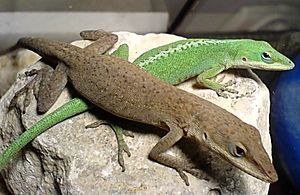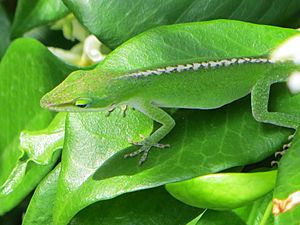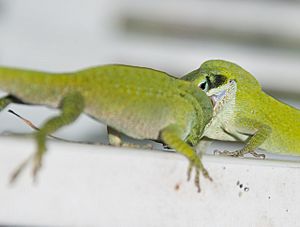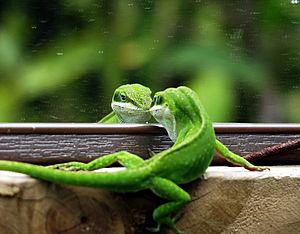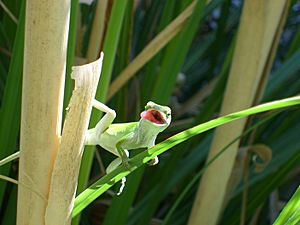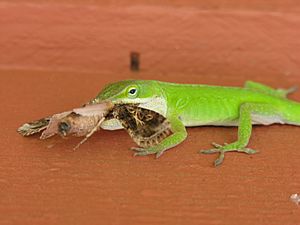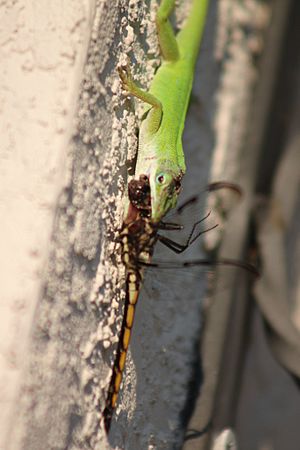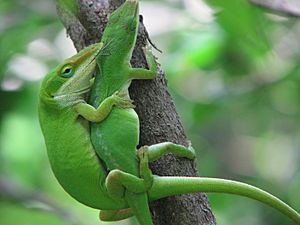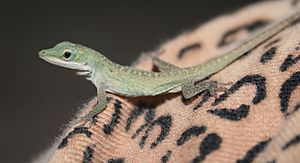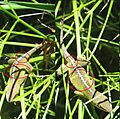Green anole facts for kids
Quick facts for kids Carolina anole |
|
|---|---|
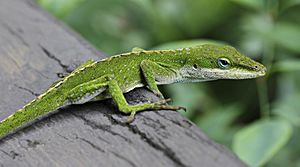 |
|
| Typical green color (above) and brown form (below) | |
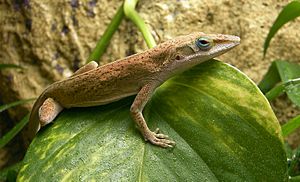 |
|
| Conservation status | |
| Scientific classification | |
| Genus: |
Anolis
|
| Species: |
carolinensis
|
| Subspecies | |
|
A. c. carolinensis |
|
The Carolina anole (Anolis carolinensis) is a small lizard that mostly lives in trees. It is found in the southeastern U.S. and Texas. It has also been brought to other places like Hawaii. People also call it the green anole or American anole. Sometimes it's called the "American chameleon" because it can change color. But it's not a true chameleon. It can change from brown to bright green.
Contents
What Does the Carolina Anole Look Like?
The Carolina anole is a small lizard with a thin body. Its head is long and pointed. It has special sticky pads on its toes. These pads help it climb trees easily.
Males and females look a bit different. Males are about 15% bigger. Male anoles have a bright red throat fan called a dewlap. It is three times larger than the female's dewlap. A female's dewlap is usually white or light pink. When males are showing off or stressed, they can raise a ridge on their back. Females often have a clear white stripe down their back. Most males do not have this stripe.
Adult male anoles are usually about 12.5 to 20.3 centimeters (5 to 8 inches) long. Most of this length is their tail. Their body is up to 7.5 cm (3 inches) long. They usually weigh from 3 to 7 grams (0.1 to 0.25 ounces).
How Carolina Anoles Change Color
Carolina anoles can change their color from green to brown. They do this like many other lizards. But anoles are related to iguanas, not true chameleons. Even though some call them "American chameleons," true chameleons are not naturally found in America.
An anole's color changes based on its mood or stress level. It also changes when it's active or sending social signals. For example, they change color to show they are in charge. It's often thought they change color to match their background, but this is not true. They might change color due to temperature, but studies are mixed on this.
Sometimes, if a strong shadow falls on an anole, its skin might change color unevenly. This can leave a temporary "stencil effect" of the shadow. When an anole is stressed, like during a fight, the skin behind its eyes can turn black. These are called "postocular spots."
Rare Color Variations
Sometimes, an anole is missing one of its color genes. This causes rare color changes. For example, a blue-phased Carolina anole lacks yellow color cells. This makes it look blue, often a light pastel blue. These blue anoles are popular as pets. If an anole has no yellow color cells at all, it's called axanthic. It will be completely pastel blue. These are very rare, about 1 in 20,000 in the wild.
There are also yellow-phased anoles. These lack blue color cells. Groups of these rare anoles have been seen. But anoles with these color changes usually don't live long. Their green color helps them hide from predators and catch food.
Where Do Carolina Anoles Live?
This lizard is native to North America. It mainly lives in the warm, subtropical parts of the southeastern U.S. They are very common in North Carolina, South Carolina, Georgia, and Florida. They also live along the Gulf Coast in Alabama, Mississippi, Louisiana, and Texas.
Carolina anoles have also been brought to places like Hawaii and the Ogasawara Islands. They have also been seen in parts of southern California.
A. carolinensis mostly lives in trees. But you might see them on the ground. They are often found on shrubs in low-lying areas. They are also common in cities on steps and railings near plants. They like moist forests and clearings with shrubs and sunlight.
Carolina Anole Behavior
Male anoles are very territorial. They will fight other males to protect their space. Some have even fought their own reflections in windows! When a male sees another male, it will flatten its body. It will extend its dewlap and raise the ridge on its back. Then it will bob its head and try to chase the other male away. If the rival doesn't leave, they will fight by biting and scratching. Serious injuries are rare. But males often have scars on their heads, especially during mating season. A male's territory is about 1 cubic meter (35 cubic feet). It usually includes two or three females.
Carolina anoles are active during the day. They are active all year, but most active in spring and fall. In winter, they are active when it's sunny and warm enough.
What Do Carolina Anoles Eat?
An anole's diet is mostly small insects. This includes crickets, grasshoppers, flies, butterflies, moths, and small beetles. They also eat other arthropods like spiders. Sometimes, they might eat grains and seeds. They have been seen eating smaller lizards like young skinks, but this is not common. People who keep anoles as pets feed them mealworms, grubs, and small crickets.
Who Hunts Carolina Anoles?
Major predators of the Carolina anole include the broadhead skink, snakes, and birds. In cities, cats also hunt them. Like many lizards, anoles can drop their tails if a predator grabs them. The tail will wiggle, distracting the predator. This helps the anole escape. A new tail will grow back. But the new tail is made of cartilage, not bone. It usually won't grow as long as the first one. It might also look different in color and texture.
Anoles can also get sick from certain flies. Adult flies lay eggs on live anoles. The fly larvae grow inside the lizard. They then come out through a wound and turn into adult flies. This infection is often deadly for the anole.
Carolina Anole Reproduction and Life Cycle
The breeding season for Carolina anoles usually starts in April and ends in late September. During this time, male anoles patrol their territory. They show off their bright colors and do elaborate dances. They extend their dewlaps and bob up and down. This display helps them attract females and warn off other males.
The male will chase a female until she is ready to mate. When she is ready, she lets him catch her. He will bite a fold of skin behind her neck to hold her. Then he positions his tail under hers. Males have two sex organs called hemipenes. They use one at a time for mating.
A female produces one egg at a time, usually every two weeks. She can lay about 10 eggs during the breeding season. She can also store sperm for up to eight months after mating. She buries her soft-shelled eggs in soft soil, leaf litter, or rotting wood. The eggs are about 12.5 mm (0.5 inches) long and 9.3 mm (0.37 inches) wide.
The sun's heat helps the eggs hatch. If successful, they will hatch in about five to seven weeks (30–45 days). This happens from late May to early October. The temperature for hatching needs to be 80 to 85 degrees Fahrenheit (27 to 29 degrees Celsius). When they hatch, the baby anoles are about 52-67 mm (2-2.6 inches) long.
The baby anoles must take care of themselves. Their parents do not look after them. Young anoles must be careful of adult anoles and other larger animals that might eat them. Younger anoles have less obvious head ridges, wider heads, and shorter tails than adults. They become adults in about eight months.
Keeping Carolina Anoles as Pets
Carolina anoles are popular pets, but they can be nervous. It's best not to handle them too often. Some anoles adapt well to living in a cage, others might not. It's important to give them the right home to keep them healthy and happy. This includes a big enough tank, the right plants, and proper bedding.
A 20-gallon (75-liter) or larger tank is good for Carolina anoles. It should have many plants along the back and sides. You can put feeder insects, like crickets, in an open area where the lizards can see them. Anoles like to jump down on their food and eat it.
In the wild, anoles interact with other anoles. You can keep several females together in the same tank. But the more lizards you have, the bigger the tank needs to be. However, you should never keep more than one adult male in a tank. They will fight over territory, which causes stress for all the anoles.
Pet owners should place a heat lamp over some of the tallest plants. This allows the anoles to bask under it. In the wild, anoles drink water droplets off leaves. So, it's best to spray water into their tank with a mist bottle. They might not drink from a water dish, even if they are very thirsty. It's important to keep the temperature and humidity in their tank just right for them.
Gallery
Images for kids
See also
 In Spanish: Abaniquillo verde del noroeste para niños
In Spanish: Abaniquillo verde del noroeste para niños



